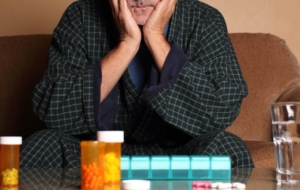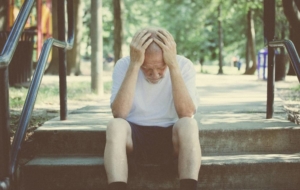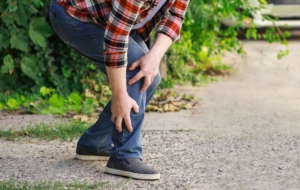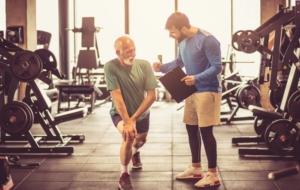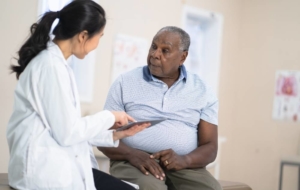According to a poll conducted by the National Center for Health Statistics, close to 1 in 10 men experience symptoms of depression and less than half were interested in seeking treatment. As men age, it has been found that feelings of depression and anxiety increase, especially after the age of 65. Additionally, a study published by the National Center for Biotechnology Information (NCBI) found that 85% of patients with chronic pain are affected by moderate to severe depression.
Unfortunately, many people avoid the conversation surrounding men’s mental health because of the taboo and cultural stigma. That’s why medical organizations need to focus on raising awareness about men’s mental health. It’s important to realize how difficult it is to live with chronic pain and depression as well as how underlying health issues can often be the cause.
Peripheral artery disease (PAD), a common vascular condition that affects the legs and feet, can cause severe pain and limited mobility that negatively impacts men’s mental health as well as their physician health. Chronic pain and mental health go hand-in-hand, which is why it’s so important to provide helpful resources for men going through depression.
Chronic Pain and Mental Health Awareness
When people with moderate to severe depression are too fatigued to get out of bed or participate in regular daily activities, their vascular health suffers.
One of the main causes of peripheral artery disease is leading a sedentary lifestyle, smoking, and eating an unhealthy diet. These behaviors are often linked to male depression at 50 or above. Aging and depression is a tough subject because there are few studies that show the seriousness as well as how it is directly linked to the development of PAD. For men’s mental health awareness month, we want to make sure people know the signs of depression and leg pain caused by PAD so they know when to seek help as well as treatment.
Signs of Depression In Men Over 40
Whether you’ve been struggling with chronic pain and mental health for some time or a family member has been, it’s important to be aware of the signs of depression in men over 40, they include:
- Feeling sad, guilty, or empty.
- Losing enjoyment in pleasurable activities or hobbies.
- Getting too much or too little of sleep.
- Having difficulty concentrating.
- Feeling fatigued more than usual.
- Experiencing aggressive or agitation at friends/family members.
- Taking part in risky behavior such as gambling or drugs.
- Avoiding social situations or family events.
- Stress feels overpowering or overwhelming.
These are just a few of the many signs of depression in men over 40. It’s important to remember that everyone is different and may experience aging and depression at various stages of their life. Check on your loved ones and take notice of any changes in behavior that may be negatively impacting their daily life.
Educating Yourself About PAD and Mental Health
Just like depression, peripheral artery disease symptoms may negatively impact your daily routine. When you are experiencing chronic pain in your legs, ankles, or feet you may feel that it weighs down on both your mental and physical health. Due to the fact that PAD reduces your mobility and independence, chronic pain and depression often lead to one another. Additionally, if you are experiencing leg pain or restlessness at night causing you to miss out on sleep, this can lead to feelings of depression as well as fatigue. According to a study published by the NCBI, 50% to 80% of people with chronic pain complained of poor sleep which caused them to avoid activity throughout their day.
The first step to educating yourself about chronic pain and depression is understanding the signs and symptoms of PAD as well as how common this vascular condition truly is. PAD affects 8 million people over the age of 40 across the United States, especially men. Common symptoms of PAD include:
- Leg pain in the buttocks, thighs, calves, ankles, or feet.
- Difficulty walking or climbing up stairs.
- Slow or non-healing wounds on the leg or feet.
- Tingling or numbness felt in the lower legs.
- One leg cooler in temperature when compared to the other.
- Paleness or blue tint to the skin on your legs.
- Poor toenail or leg hair growth.
- Restlessness in the legs or feet, felt especially at night.
- Erectile dysfunction.
Educating yourself and others about PAD helps more people notice changes they may be experiencing. PAD is easily treatable as long as it is diagnosed and addressed early on. Untreated PAD can lead to serious health conditions like heart attack, stroke, or gangrene.
Even though PAD also affects women, men are more at risk. Additionally, men with diabetes, a family history of vascular disease, and high blood pressure/cholesterol, have an increased risk for developing PAD.
Learn how gender plays a key role in the development and severity of peripheral artery disease.
Depression and Leg Pain Prevention
We want men and women alike to know they don’t have to put up with the endless circle of dealing with depression and leg pain. Living with limited mobility can be frustrating and stressful. Many people with PAD feel they have to rely on others to assist them, which causes a loss of independence and control. Thankfully, there are a few ways you can avoid painful vascular conditions like peripheral artery disease; such as:
- Exercise and stretch your legs daily.
- Avoid smoking tobacco products including pipes and cigarettes.
- Consult your physician about early signs and symptoms of PAD.
- Manage your blood pressure and cholesterol levels with a healthy diet and/or medication.
- Learn about your family’s medical history to see if you may be at an increased risk.
- Eat a healthy diet and avoid foods high in sodium, cholesterol, salt, and sugar.
- Avoid red meats and fatty pork dishes like sausage or pepperoni.
- Monitor other health conditions such as diabetes, especially type 2.
If you’re experiencing depression and leg pain, we don’t want you to feel like prevention is out of reach. Even if you are diagnosed with PAD, there are lifestyle changes and medications a vascular specialist can recommend to slow the accumulation of arterial plaque. The most important thing is to be proactive about your health and inform your doctor of leg pain or other symptoms. Due to the fact that symptoms of depression and physical pain are often ignored, it’s important to push family members or friends to seek help before their condition worsens.
How Family Can Help Someone with Depression and Physical Pain
If you have a family member who is experiencing depression and physical pain, there are a few ways you can help:
- Encourage them to consult a vascular specialist about their leg pain or other symptoms.
- Avoid smoking around them.
- Inform a doctor if you’ve noticed physical signs like open wounds on their legs or them having difficulty walking/climbing stairs.
- Suggest to exercise with them or participate in healthy activities like taking the stairs versus the elevator.
- Set a good example by adopting a healthy diet.
- Send them helpful resources or education materials about mental health and PAD.
Family members or friends often feel helpless when they see their loved one going through depression and physical pain. The above list are just a few of the many small activities you can do during men’s mental health awareness month. Family and friends often play a key role in helping people battle both mental and physical health issues.
Tips to Improve Men’s Mental Health and Physical Well-Being
Not only does treating the underlying cause of your depression and leg pain work well for both your mental and physical well being, but there are also a few tips you can try to elevate your mood on a daily basis; such as:
- Participating in light aerobics or yoga for at least 30 minutes per day.
- Taking the stairs whenever you get a chance, even a few at a time count.
- Wearing comfortable, nonrestrictive clothes especially on the legs and feet.
- Stretching every hour during the day to prevent idleness.
- Managing your blood pressure and cholesterol levels.
- Quitting smoking as well as avoiding people who smoke (secondhand).
- Breathing techniques to lower stress levels which can elevate blood pressure.
- Eating a diet low in sodium, sugar, and cholesterol.
- Getting on a good sleep schedule and limiting distractions like lights and sounds.
- Talking to your doctor about symptoms you may be experiencing.
- Writing down changes in your diet, weight, libido, mobility, etc. in a notebook.
Even completing just a few of things during men’s mental health month can make a major impact on aging and depression. The most important men’s mental health tip is to confide in a vascular specialist if you think you are experiencing depression and leg pain symptoms. Ignoring symptoms can be detrimental to every aspect of your life.
Treatment for Depression and Leg Pain Caused by PAD
Untreated depression and leg pain can be difficult to live with, especially as you age. Solving the underlying arterial issue can bring solace to many men struggling with painful peripheral artery disease symptoms. When you’re free of chronic leg pain and you finally get increased mobility, you’ll be able to live a healthier, more active life. This ultimately increases stamina and dopamine, positively affecting your mental health.
At USA Vascular Centers, we use minimally invasive, outpatient techniques and tools to treat semi or fully-blocked arteries. We are able to diagnose the severity of your PAD and recommend a treatment plan that is right for you. Depending on your unique situation and needs, lifestyle changes and medication might be enough. However, if you are living with moderate to severe PAD, a non-surgical procedure may be right for you. Explore our website to learn more about our vascular specialists, locations, and treatments.
Men’s mental health month doesn’t just stop here, learning more and consulting a physician about how treating underlying PAD symptoms can help. Give us a call at 888-773-2193 or conveniently schedule an initial consultation online. Don’t wait for your depression and leg pain to worsen. Our specialists can improve chronic pain and mental health by treating the underlying issue in no time.

